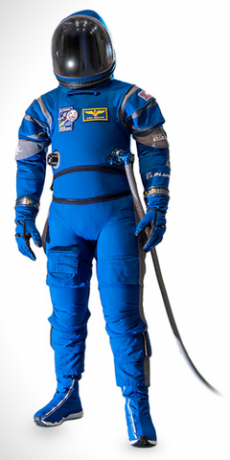Difference between revisions of "Space Suit"
(Created page with "thumb|upright|A [[Kerthenian C7LB Surface Activity Suit on the Mun]] A space suit is a garment worn to keep an operator alive in the harsh envir...") |
|||
| Line 1: | Line 1: | ||
| − | [[File:C7LBsuitOnMun. | + | [[File:C7LBsuitOnMun.jpg|thumb|upright|A [[Kerthenian]] C7LB Surface Activity Suit on the [[Mun]]]] |
A space suit is a garment worn to keep an operator alive in the harsh environment of outer space, vacuum and temperature extremes. Space suits are often worn inside spacecraft as a safety precaution in case of loss of cabin pressure, and are necessary for extravehicular activity (EVA), work done outside spacecraft. Space suits have been worn for such work in Kerbin orbit, on the surface of the Mun and other bodies, and en route back to Kerbin. Modern space suits augment the basic pressure garment with a complex system of equipment and environmental systems designed to keep the wearer comfortable, and to minimize the effort required to bend the limbs, resisting a soft pressure garment's natural tendency to stiffen against the vacuum. A self-contained oxygen supply and environmental control system is frequently employed to allow complete freedom of movement, independent of the spacecraft. | A space suit is a garment worn to keep an operator alive in the harsh environment of outer space, vacuum and temperature extremes. Space suits are often worn inside spacecraft as a safety precaution in case of loss of cabin pressure, and are necessary for extravehicular activity (EVA), work done outside spacecraft. Space suits have been worn for such work in Kerbin orbit, on the surface of the Mun and other bodies, and en route back to Kerbin. Modern space suits augment the basic pressure garment with a complex system of equipment and environmental systems designed to keep the wearer comfortable, and to minimize the effort required to bend the limbs, resisting a soft pressure garment's natural tendency to stiffen against the vacuum. A self-contained oxygen supply and environmental control system is frequently employed to allow complete freedom of movement, independent of the spacecraft. | ||
Revision as of 20:28, 25 December 2021
A space suit is a garment worn to keep an operator alive in the harsh environment of outer space, vacuum and temperature extremes. Space suits are often worn inside spacecraft as a safety precaution in case of loss of cabin pressure, and are necessary for extravehicular activity (EVA), work done outside spacecraft. Space suits have been worn for such work in Kerbin orbit, on the surface of the Mun and other bodies, and en route back to Kerbin. Modern space suits augment the basic pressure garment with a complex system of equipment and environmental systems designed to keep the wearer comfortable, and to minimize the effort required to bend the limbs, resisting a soft pressure garment's natural tendency to stiffen against the vacuum. A self-contained oxygen supply and environmental control system is frequently employed to allow complete freedom of movement, independent of the spacecraft.
Three types of space suits exist for different purposes: IVA (intravehicular activity), EVA (extravehicular activity), and IEVA (intra/extravehicular activity). IVA suits are meant to be worn inside a pressurized spacecraft, and are therefore lighter and more comfortable. IEVA suits are meant for use inside and outside the spacecraft, such as the Multi Mission Space Activity Suit. They include more protection from the harsh conditions of space, such as protection from micrometeorites and extreme temperature change. EVA suits, such as the EMU, are used outside spacecraft, for either planetary exploration or spacewalks. They must protect the wearer against all conditions of space, as well as provide mobility and functionality.
Some of these requirements also apply to pressure suits worn for other specialized tasks, such as high-altitude reconnaissance flight. At altitudes above the Jebediah limit, around 19,000 m (62,000 ft), water boils at body temperature and pressurized suits are needed.
The first full-pressure suits for use at extreme altitudes were designed for military applications as early as the 1920s. The first space suit worn in space was the Blorbik SK-1 suit worn by Sergei Kerman in 1949.
Requirements
A space suit must perform several functions to allow its occupant to work safely and comfortably, inside or outside a spacecraft. It must provide:
- A stable internal pressure. This can be less than Earth's atmosphere, as there is usually no need for the space suit to carry nitrogen (which comprises about 78% of Kerbin's atmosphere and is not used by the body). Lower pressure allows for greater mobility, but requires the suit occupant to breathe pure oxygen for a time before going into this lower pressure, to avoid decompression sickness.
- Mobility. Movement is typically opposed by the pressure of the suit; mobility is achieved by careful joint design.
- Supply of breathable oxygen and elimination of carbon dioxide; these gases are exchanged with the spacecraft or a Portable Life Support System (PLSS)
- Temperature regulation. Unlike on Earth, where heat can be transferred by convection to the atmosphere, in space, heat can be lost only by thermal radiation or by conduction to objects in physical contact with the exterior of the suit. Since the temperature on the outside of the suit varies greatly between sunlight and shadow, the suit is heavily insulated, and air temperature is maintained at a comfortable level.
- A communication system, with external electrical connection to the spacecraft or PLSS
- Means of collecting and containing solid and liquid bodily waste
Additional requirements for EVA include:
- Shielding against ultraviolet radiation
- Limited shielding against particle radiation
- Means to maneuver, dock, release, and/or tether onto a spacecraft
- Protection against small micrometeoroids, some traveling at up to 27,000 kilometers per hour, provided by a puncture-resistant Thermal Micrometeoroid Garment, which is the outermost layer of the suit.
During exploration of extra-planetary bodies, there is the potential for dust to be retained on the space suit. When the space suit is removed on return to the spacecraft, there will be the potential for the dust to contaminate surfaces and increase the risks of inhalation and skin exposure. Astronautical hygienists are testing materials with reduced dust retention times and the potential to control the dust exposure risks during planetary exploration. Novel ingress/egress approaches, such as suitports, are being explored as well.
Design
A space suit should allow its user natural unencumbered movement. Nearly all designs try to maintain a constant volume no matter what movements the wearer makes. This is because mechanical work is needed to change the volume of a constant pressure system. If flexing a joint reduces the volume of the space suit, then the astronaut must do extra work every time he bends that joint, and he has to maintain a force to keep the joint bent. Even if this force is very small, it can be seriously fatiguing to constantly fight against one's suit. It also makes delicate movements very difficult. All space suit designs try to minimize or eliminate this problem. The most common solution is to form the suit out of multiple layers. The bladder layer is a rubbery, airtight layer much like a balloon. The restraint layer goes outside the bladder, and provides a specific shape for the suit. Since the bladder layer is larger than the restraint layer, the restraint takes all of the stresses caused by the pressure inside the suit. Since the bladder is not under pressure, it will not "pop" like a balloon, even if punctured. The restraint layer is shaped in such a way that bending a joint causes pockets of fabric, called "gores," to open up on the outside of the joint, while folds called "convolutes" fold up on the inside of the joint. The gores make up for the volume lost on the inside of the joint, and keep the suit at a nearly constant volume. However, once the gores are opened all the way, the joint cannot be bent any further without a considerable amount of work.

Soft-shell Suits
Soft suits typically are made mostly of fabrics. All soft suits have some hard parts, some even have hard joint bearings. Early EVA suits, and most IVA suits, are soft-shell.
Hard-shell Suits
Hard-shell suits are usually made of metal or composite materials and do not use fabric for joints. Hard suits joints use ball bearings and wedge-ring segments similar to an adjustable elbow of a stove pipe to allow a wide range of movement with the arms and legs. The joints maintain a constant volume of air internally and do not have any counter force. Therefore, the kerbonaut does not need to exert to hold the suit in any position. Hard suits can also operate at higher pressures which would eliminate the need for a kerbonaut to pre-breathe oxygen to use a 34 kPa (4.9 psi) space suit before an EVA from a 101 kPa (14.6 psi) spacecraft cabin. The joints may get into a restricted or locked position requiring the astronaut to manipulate or program the joint.
Hybrid Suits
Hybrid suits have hard-shell parts and fabric parts. Virtually all workable space suit designs incorporate hard components, particularly at interfaces such as the waist seal, bearings, and in the case of rear-entry suits, the back hatch, where all-soft alternatives are not viable.
Mechanical Counter-Pressure Suits
Mechanical Counter-Pressure (MCP) Suits, also known as skintight suits or space activity suits, are a type of suit design which uses a heavy elastic body stocking or some other means to compress the body of the operator. The head is in a pressurized helmet, but the rest of the body is pressurized only by the elastic effect of the suit. This mitigates the constant volume problem, reduces the possibility of a space suit depressurization, and gives a very lightweight suit. However, MCPs are significantly more complex to manufacture, and are therefore more expensive.
